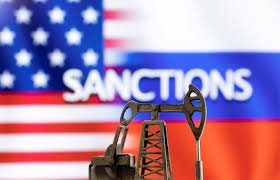On Thursday, US treasury officials confirmed that they did not release any sanctions against India for importing Russian oil. During the second phase of the price cap imposed on the acquisition of Russian oil, the Ministry of External Affairs stated that India’s decisions are influenced by its energy security needs, which remain the primary focus.
According to two US officials on Thursday, India has not been requested by the United States to decrease its imports of Russian oil. The price cap and sanctions regime enforced by the G7 are intended to diminish Moscow’s profits from crude sales and hinder its capability to finance the war in Ukraine.
Why was this done?
U.S. Treasury department officials visiting Delhi on April 4 adopted a conciliatory approach regarding India’s imports of Russian oil. They clarified that the objective of U.S. sanctions and the oil “price cap” was not to restrict the acquisition of Russian ‘Ural’ oil but rather to constrain the revenues accruing to the “Kremlin”.
The justification of the US officials
US officials, following briefings with their Indian counterparts regarding the second phase of implementing the price cap initiated in December 2022, highlighted their focus on channels established by Russia for exporting crude without reliance on Western service providers for shipping or insurance.
Speaking at the Ananta Centre, US assistant secretary for economic policy Eric Van Nostrand and acting assistant secretary for terrorist financing Anna Morris clarified that there hasn’t been a recent demand for India to decrease Russian oil imports. Nostrand emphasized the objective of limiting Russian President Vladimir Putin’s profits from oil sales through the policy in place.
Morris pointed out the detection of Russian efforts since the latter half of 2023 to construct a “shadow fleet” involving ships, insurers, and maritime services with opaque ownership structures, diverting investments from the conflict in Ukraine. They expressed satisfaction with Russia’s expenditure on oil tankers rather than military equipment, yet emphasized the need to respond to the expanded channel for oil movement outside Western coalition services.
Following Russia’s invasion of Ukraine, the US and its allies urged India not to purchase discounted Russian commodities, particularly oil and fertilizers. Despite not openly criticizing Moscow, India increased its procurement of Russian crude, causing Russia to surpass traditional energy suppliers like Saudi Arabia and Iraq.
Indian authorities justified their actions by aiming to ensure affordable energy supplies amid global market volatility. However, payment issues arose, especially after substantial sums in Russian bank accounts in India accumulated.
Regarding India paying for Russian oil in currencies like the UAE dirham, US officials declined to comment. They acknowledged that the $60 per barrel price cap wouldn’t apply to crude imports not utilizing Western coalition shipping or services.
The price cap imposed by the G7, EU, and Australia prohibits Western services in insurance and transportation for tankers carrying Russian oil priced above $60 per barrel. Since October 2023, the coalition intensified enforcement of the price cap and increased costs for Russia to sell oil through the “shadow fleet.”
In February, the US Treasury Department designated Sovcomflot, Russia’s state-owned shipping company, and identified 14 of its oil tankers as “blocked property.”
Morris noted a decline in Russian oil prices compared to global prices and emphasized the intent of phase two of the price cap to make it challenging for Russia to move oil outside Western coalition services. This would either force Russia to sell more oil under the cap with coalition services or offer greater discounts to non-coalition buyers.
Conclusion
In conclusion, the latest developments surrounding India’s imports of Russian oil shed light on the complexities of global energy dynamics amid geopolitical tensions.
Despite the imposition of sanctions and a price cap by the G7 nations, India’s stance remains primarily driven by its energy security needs. US Treasury officials have adopted a conciliatory tone, emphasizing that their aim is not to limit India’s access to Russian oil but rather to curb revenues flowing to the Kremlin. However, the emergence of alternative channels for Russian oil exports underscores the challenges in enforcing such measures effectively. As India navigates its energy policy in this uncertain landscape, balancing its strategic interests with international pressure remains a delicate task.












Comments 2